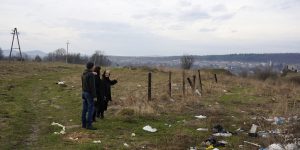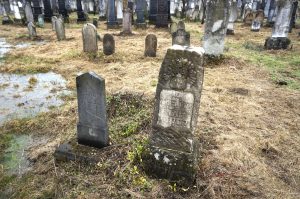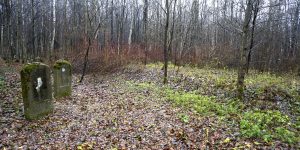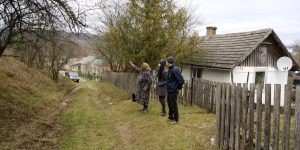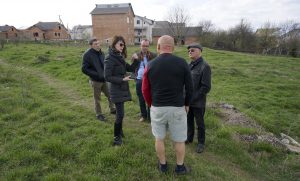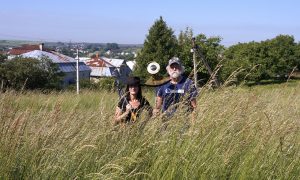![]() Ця сторінка також доступна українською.
Ця сторінка також доступна українською.
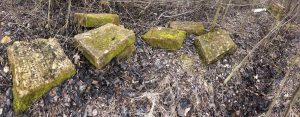
Headstone fragments returned to the Jewish cemetery of Nyzhniv (Ivano-Frankivsk oblast). Photo © RJH.
On the home page of this website, we briefly explain the origins and purpose of this research project and the resources organized and presented on the many other pages of the site. In the discussion below, we describe in greater detail the motivations which have driven this project for some years, even before it coalesced into the material available on the site.
In the guide and the other sections of this website, we don’t consider the motivations for people to become activists, volunteers, and local or remote supporters of heritage projects; generally we don’t address the who and the why of projects. Instead we take for granted that some people will want to create and lead projects, or to help those who stand up for Jewish heritage in western Ukraine. Our focus is on the where, the what, and especially on the how of projects, because in our experience those are the aspects most in need of information, resources, and guidance.
But we do discuss, only on this page, our own motivations for doing the research and publishing what we have learned, because we know from many discussions with others here in western Ukraine and abroad that our experience is not unique; our challenges are in fact common, and, apart from locating Jewish burial sites, institutional resources are scarce. Most successful heritage activists are individuals who achieve their results through continuous force of will and from their own personal resourcefulness.
What exactly are the challenges to preserving Jewish burial sites in western Ukraine?
Spatial Memory – Locating the Burial Sites
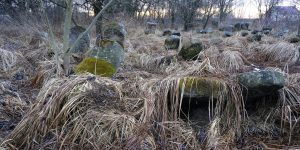
Heavy grasses covering the tilted headstones in the cemetery of Rozhniativ (Ivano-Frankivsk oblast). Photo © RJH.
The 2005 Jewish heritage sites report for Ukraine published by the US Commission for the Preservation of America’s Heritage Abroad (USCPAHA) highlights this first issue very well. The five-year survey completed 20 years ago struggled to identify and locate Jewish cemeteries and mass graves: “There was no prior list of cemeteries to work from, nor any previous similar inventory or survey. Finding the locations of cemeteries was difficult.” [p.4] “The greatest danger is in the western part of Ukraine, the region that was under Polish control between the wars and was completely occupied by the German army. In that region, where many historic [Jewish] communities no longer exist, the cemeteries remain unprotected and at great risk.” [p.23]
Preservation requires identification as a first step, but with local Jewish communities destroyed and almost no Jewish presence for decades, the link between place and memory has become severely broken. The USCPAHA and their surveyors on the ground found and identified more than 1300 Jewish burial sites (731 cemeteries, 495 mass graves) across Ukraine. As a clue to the size of prewar Jewish presence in western Ukraine, one-fifth of all the cemeteries were found in the three oblasts of former eastern Galicia, and one-third of Ukraine’s total was found in the five oblasts which make up the larger western Ukraine – a density of cemeteries more than double the fraction of the population and area of these oblasts in modern Ukraine.
Confirming the difficulty of this first survey, the USCPAHA wrote in their summary: “It is believed that several hundred more Jewish burial grounds and mass graves exist within the present-day boundaries of Ukraine.” [p.22] Studies by other institutions, principally Yahad – In Unum, Lo Tishkach, and now also ESJF European Jewish Cemeteries Initiative, have since validated that belief. Through archives research, interviews with Jewish survivors, site visits and measurements, and especially interviews with elderly local people in the towns and villages, many new burial sites have been identified and located, particularly in western Ukraine. In the three-oblast eastern Galicia region, the number of identified Jewish cemeteries is now 60% higher than the count originally documented by the USCPAHA 15 years ago, and the number of identified mass graves is now seven times the former number. Both Yahad – In Unum and ESJF are still actively researching the region, and smaller organizations are also now contributing to this work, so we share the belief that even more sites will be identified and located, despite the rapidly-diminishing human memory resources available for interviews and site visits.

The overbuilt site of the first Jewish cemetery in Tysmenytsia (Ivano-Frankivsk oblast). Photo © RJH.
A Hard Break in the Traditional Model of Community Care of Burial Sites
Again from the USCPAHA 2005 survey report: “During the war, nearly all of Ukraine was occupied by invading German armies. Hundreds of historic communities, especially in western Ukraine, were completely destroyed at the hands of the German invaders.” [p.17] “The Jews of Ukraine currently constitute the third largest Jewish community in Europe and the fifth largest in the world. Western Ukraine, however, has only a small remnant of its former population, with Lviv and Chernivtsi each having only about 6,000 Jews.” [p.13]
To be clear, except for the larger cities, there are no Jewish communities in western Ukraine today. In nearly every town or village where there are identified Jewish burial sites, there is not even one resident Jew. Even in cities where Jews can assemble a minyan, the congregations are poor, aging, and diminishing. After centuries of Jewish communal care for cemeteries, that model is broken and cannot be repaired. Given the hundreds of identified Jewish burial sites in western Ukraine, the preservation challenge is a staggering weight for the regional communities to bear.
The economic weakness of a country only recently self-governing and currently in a territorial war with a much larger neighbor means that Ukrainian government resources and management at the national, regional, and local level are understandably scarce; in travel through the region, we often see cemeteries of all faiths in need of clearing, conservation, and repair. Civil society organizations and regional NGOs are small and mostly staffed by volunteers; attempts to network and to pool information and ideas are difficult to extend beyond an initial discussion stage when there are few resources to share.
Individual Activists, Both Local and Remote – Gaps in Knowledge and Skills

Headstones from the Jewish cemetery of Pomoriany (Lviv oblast) used in the foundation of a Soviet-era farm building. Photo © RJH.
Under wartime German occupation, the intentional damage to Jewish cultural sites in western Ukraine, including the demolition of cemeteries, was nearly as complete as the destruction of the Jewish communities which had created them. State-sponsored re-purposing of Jewish headstones and even cemetery grounds during the Communist period added to the loss. Forced resettlement of ethnic groups and suppression of religion amplified the “forgetting” of Jewish cemeteries and mass grave sites until near the end of the Soviet era. By the 1980s, however, Soviet authorities began to mark some Jewish mass grave sites, not as recognition of the Shoah per se, but as part of an anti-fascist social campaign. This provided an opportunity for those who had lived through the war, mostly ethnic Ukrainians but also a small number of Ukrainian Jews, to discuss the conflict and its impact on the heritage sites.
Soon after Soviet rule ended in Ukraine in 1991, Jewish survivors in Israel, North America, and elsewhere worked within families and within mutual aid societies (landsmanshaftn) to memorialize their lost communities, to fence cemeteries, and to place markers at burial sites of all types; many of those projects were conducted with the cooperation and support of local historians and civic and religious leaders in newly-independent Ukraine. Nearly a hundred commemorative markers or other memorial projects were installed at Jewish burial sites in western Ukraine during two vigorous decades until the number of survivors and their Ukrainian peers with first-hand experience of the war dwindled too much to sustain the effort. Those early markers and fences of course also show their age today, and slowly decay.
Now the effort is driven by the next generations, both Jewish and local Ukrainian. Without direct experience of the prewar Jewish heritage sites, and after dramatic changes to the appearance of heritage landscapes during and after the war, it can be difficult for foreign Jewish descendants and local people alike to visualize what the sites had been, how they carry memory, and what can be done with them now. Visiting denuded cemeteries can be depressing, mass graves even more so – when they can be found. For almost anyone with a desire to better mark and care for Jewish burial sites, they must first overcome significant psychic distance: geographical, historical, and/or cultural, depending on one’s starting point.
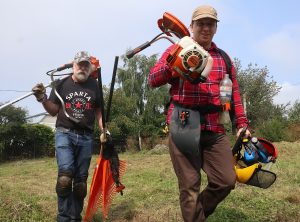
Learning on the job with The Matzevah Foundation in the old Jewish cemetery of Rohatyn (Ivano-Frankivsk oblast). Photo © Steven D. Reece.
Most individual activists lack knowledge, skills, and experience with the issues inherent in heritage preservation work in the region. Despite regular calls at conferences and round-tables in Europe and elsewhere for the development of best practices in Jewish cemetery preservation, and several high-level statements by leaders in European Jewish heritage studies over the past decade, almost no practical (and region-appropriate) advice and information resources have been published in any language and in a format freely accessible by the public. We encountered this void during the development of our own individual project in Rohatyn in western Ukraine, and observed it also while broadly reviewing Jewish heritage concerns for two years in Poland. In the absence of formal resources, we began learning practical methods several years ago by working hand-in-hand with the small number of skilled activists active in east-central Europe, by studying the available print and web resources (even if not regionally relevant), and by trial and error with friends and colleagues working as volunteers on their projects or on ours. We are not experts, and never will be, but we have had enough exposure to both the magnitude of the challenge and the small strategies and methods which seem to work, that we feel there is value in what we have gathered and learned, worth sharing with those interested in taking an active role in the care and management of the surviving heritage. This project pushed us to gather and learn even more, especially in fields where our practical work had not yet led us.

Jewish headstones unearthed during grounds work at a former palace in Zolotyi Potik (Ternopil oblast). Photo © RJH.
Our Personal Motivations for the Research and Publication
The primary impetus for this research project came from the several inquiries we get every week: from others who hope to organize a Jewish cemetery project in their ancestors’ town or village in western Ukraine or nearby, but do not know how to start; from Ukrainians in towns with overgrown Jewish cemeteries or derelict mass grave memorial markers, wondering who can bring resources to bear to help them rehabilitate the sites; from foreign Jewish descendants who are unable to find information about where their relatives are even buried. Although our primary focus has always been the history and heritage of a single town in western Ukraine, we visit other sites in the region with friends throughout the year, and we maintain a lively social media presence with images and information about these places. The travel regularly brings us into contact with local people who carry memory about the lost Jewish communities and their heritage, and the internet postings attract people from all over the world who yearn to somehow do something. Clearly we cannot lead more than our own individual heritage project, but we can publish the methods, references, tools, examples, and advice we have seen and experimented with over the past several years, so that other potential activists can scope, start, and lead projects of their own.
We want to emphasize that these kinds of projects can succeed slowly and in more ways than are immediately apparent. Demonstrations of interest and care in the form of basic vegetation clearing, signage, fence repair, and even simply visiting the sites, inform the residents of regional towns and villages that there is a sustained connection to the sites which others treasure. We have repeatedly seen the anonymous return of Jewish headstone fragments to recently-worked cemeteries, the placement of memorial candles and flowers at cleaned monuments and mass grave sites, and other signs of local memory and respect. Even as the stone, metal, and wood materials at these burial sites inevitably decay, this attention to the past is comforting. When integrated with local interests and concerns, Jewish heritage projects can raise awareness of diversity and coexistence, contribute to peacekeeping and tolerance, and counteract xenophobia and racist attitudes.
This research project has expanded since the original proposal submitted to the Fulbright scholarship program. While portions focused specifically on Rohatyn’s old Jewish cemetery have progressed as planned, over the course of the project the “lessons learned” and “best practices” portions intended for wider use in the region grew in both breadth and depth (as well as in time and effort). This is understandable; we have always said that Rohatyn’s Jewish heritage is typical of the hundreds of Jewish heritage sites in the region, so what we learn and the mistakes we make are likely to be helpful to many others despite the variety of history and challenges which make the region interesting.
Although this website was largely assembled by the two people named below, the research project and its materials significantly benefited from the contributions of advice, information, data, and experience of a great many people and institutions, to whom we are grateful and all of whom we are very pleased to acknowledge. Forward progress to identify, preserve, and protect Jewish burial sites in western Ukraine will of course depend on the ongoing efforts of an even larger number of people, some of whom we will never know, but all of whom promote tikkun olam and a path toward repairing the world.
Marla Raucher Osborn
Jay Osborn
Rohatyn Jewish Heritage


